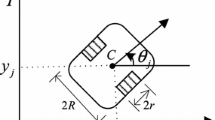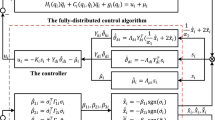Abstract
This work reports a radial basis Artificial Neural Network controller that solves the leader-follower and leaderless pose (position and orientation) consensus problems, in the Special Euclidean space of dimension three (SE(3)), in robot networks composed of heterogeneous (kinematically and dynamically different) and uncertain robots. The proposed approach employs, the singularity-free, unit-quaternions to represent the orientation of the end-effectors in the SE(3). The performance of the proposed controller is illustrated via simulations with a five heterogeneous robot network.
Similar content being viewed by others
References
N. Karayiannis and A. Venetsanopoulos, Artificial Neural Networks: Learning Algorithms, Performance Evaluation, and Applications. The Springer International Series in Engineering and Computer Science, Springer US, 2013.
W. Chen, S. Hua, and H. Zhang, “Consensus-Based Distributed Cooperative Learning From Closed-Loop Neural Control Systems,” IEEE transactions on Neural Networks and Learning Systems, vol. 26, no. 2, pp. 331–345, 2015.
B. Dexu, S. Wei, Y. Hongshan, W. Cong, and Z. Hui, “Adaptive robust control based on rbf neural networks for duct cleaning robot,” International Journal of Control, Automation and Systems, vol. 13, no. 2, pp. 475–487, 2015. [click]
S.-I. Han and J.-M. Lee, “Decentralized neural network control for guaranteed tracking error constraint of a robot manipulator,” International Journal of Control, Automation and Systems, vol. 13, no. 4, pp. 906–915, 2015. [click]
W. Chen, S. Hua, and S. Sam Ge, “Consensus-based distributed cooperative learning control for a group of discrete-time nonlinear multi-agent systems using neural networks,” Automatica, vol. 50, no. 9, pp. 2254–2268, 2014. [click]
R. Olfati-Saber, J. A. Fax, and R. M. Murray, “Consensus and Cooperation in Networked Multi-Agent Systems,” Proc. IEEE, vol. 95, no. 1, pp. 215–233, 2007.
E. Nuño, R. Ortega, B. Jayawardhana, and L. Basañez, “Coordination of multi-agent Euler-Lagrange systems via energy-shaping: Networking improves robustness,” Automatica, vol. 49, pp. 3065–3071, Oct. 2013. [click]
J. Klotz, Z. Kan, J. M. Shea, E. L. Pasiliao, and W. E. Dixon, “Asymptotic synchronization of leaderfollower networks of uncertain euler-lagrange systems,” IEEE Transactions on Control of Network Systems, vol. 2, no. 2, pp. 174–182, 2015.
Z. Liu, X. You, H. Yang, and L. Zhao, “Leader-following consensus of heterogeneous multi-agent systems with packet dropout,” International Journal of Control, Automation and Systems, pp. 1–9, 2015.
Y. Liu, S. Wang, H. Min, L. Ma, and D. Luo, “Distributed finite-time regulation of a class of networked heterogeneous multi-agent systems,” International Journal of Control, Automation and Systems, vol. 13, no. 1, pp. 65–72, 2015. [click]
E. Nuño, R. Ortega, L. Basañez, and D. Hill, “Synchronization of networks of nonidentical Euler-Lagrange systems with uncertain parameters and communication delays,” IEEE Trans. Autom. Control, vol. 56, no. 4, pp. 935–941, 2011.
S. Djaidja, Q.-H. Wu, and H. Fang, “Leader-following consensus of double-integrator multi-agent systems with noisy measurements,” International Journal of Control, Automation and Systems, vol. 13, no. 1, pp. 17–24, 2015. [click]
C.-C. Hua, Y. Yang, and X. Guan, “Neural network-based adaptive position tracking control for bilateral teleoperation under constant time delay,” Neurocomputing, vol. 113, pp. 204–212, Aug. 2013. [click]
C. Miranda, A. De-la mora, and E. Nuño, “Control of Uncertain Teleoperators with Time-Delays using Artificial Neural Networks,” in The International Federation of Automatic Control World Congress, (Cape Town, South Africa), pp. 1766–1771, 2014.
S. El-Ferik, A. Qureshi, and F. L. Lewis, “Neuro-adaptive cooperative tracking control of unknown higher-order affine nonlinear systems,” Automatica, vol. 50, no. 3, pp. 798–808, 2014. [click]
Z. Li, X. Cao, and N. Ding, “Adaptive fuzzy control for synchronization of nonlinear teleoperators with stochastic time-varying communication delays,” IEEE Transactions on Fuzzy Systems, vol. 19, no. 4, pp. 745–757, 2011.
Z. Li and Y. Xia, “Adaptive neural network control of bilateral teleoperation with unsymmetrical stochastic delays and unmodeled dynamics,” Int. Jour. of Robust and Nonlinear Control, vol. 24, no. 11, pp. 1628–1652, 2014. [click]
Z. Li and C.-Y. Su, “Neural-adaptive control of singlemaster-multiple-slaves teleoperation for coordinated multiple mobile manipulators with time-varying communication delays and input uncertainties,” IEEE Transactions on Neural Networks and Learning Systems, vol. 24, no. 9, pp. 1400–1413, 2013.
A. Abdessameud, A. Tayebi, and I.-G. Polushin, “Attitude synchronization of multiple rigid bodies with communication delays,” IEEE Trans. Autom. Control, vol. 57, no. 9, pp. 2405–2411, 2012.
W. Ren, “Distributed attitude alignment in spacecraft formation flying,” Int. J. Adapt. Contr. Signal Process., vol. 21, no. 2-3, pp. 95–113, 2007.
Y. Igarashi, T. Hatanaka, M. Fujita, and M. Spong, “Passivity-based attitude synchronization in SE(3),” IEEE Trans. Control Syst. Technol., vol. 17, no. 5, pp. 1119–1134, 2009.
S. Weng, D. Yue, and T. Yang, “Coordinated attitude motion control of multiple rigid bodies on manifold SO(3),” IET Control Theory & Applications, vol. 7, no. 16, pp. 1984–1991, 2013.
H. Bai, M. Arcak, and J. Wen, “Rigid body attitude coordination without inertial frame information,” Automatica, vol. 44, no. 12, pp. 3170–3175, 2008. [click]
J. T.-Y. Wen and K. Kreutz-Delgado, “The attitude control problem,” IEEE Transactions on Automatic Control, vol. 36, no. 10, pp. 1148–1162, 1991.
W. Ren and Y. Cao, Distributed Coordination of Multi-Agent Networks: Emergent Problems, Models, and Issues. Springer-Verlag London Limited, 2011.
M. W. Spong, S. Hutchinson, and M. Vidyasagar, Robot Modeling and Control. John Wiley & Sons, 2005.
J. Funda, R. H. Taylor, and R. P. Paul, “On homogeneous transforms, quaternions, and computational efficiency,” in IEEE Transactions on Robotics and Automation, vol. 6, pp. 382–388, 1990.
H. D. Patiño, R. Carelli, and B. R. Kuchen, “Neural Networks for Advanced Control of Robot Manipulators,” IEEE Transactions on Neural Networks, vol. 13, no. 2, pp. 343–354, 2002.
C. I. Aldana, E. Romero, E. Nuño, and L. Basañez, “Pose consensus in networks of heterogeneous robots with variable time delays,” International Journal of Robust and Nonlinear Control, vol. 25, pp. 2279–2298, June 2014. [click]
R. A. Spurrier, “Comment on "Singularity-Free Extraction of a Quaternion from a Direction-Cosine Matrix",” Journal of Spacecraft and Rockets, vol. 15, no. 4, pp. 255–255, 1978. [click]
Author information
Authors and Affiliations
Corresponding author
Additional information
Recommended by Associate Editor DaeEun Kim under the direction of Editor Myp Taeg Lim. The first and second authors thank the Mexican CONACyT for the Ms.C. grant 295996 and the Repatriación grant 262724, respectively. This work has been partially supported by the Spanish MINECO projects DPI2013-40882-P, DPI2014-57757-R and DPI2016-80077-R.
Remberto Machuca was born in Guadalajara, México, in 1985. He obtained his B.Sc. degreee in Biomedical Engineering from the University of Guadalajara, in Guadalajara, Mexico, in 2012. Currently, he is enrolled in the Department of Computer Science at the University of Guadalajara to obtain the M. Sc. degree in Electronic Engineering and Computer Science. His research interests include artificial neural networks, teleoperation and consensus of multiple Euler- Lagrange systems. Other interests include robotics, prosthetics, and nanomaterials; areas in which he has indexed scientific journal publications.
Rodrigo Munguía was born in Guadalajara, México. He received the Ph.D. degree in Electrical Engineering (2009) and the M.S. degree in computer science (2006) from the Technical University of Catalonia (UPC), Spain. He received the B.Eng. degree in engineering from the University of Guadalajara, Guadalajara, Mexico. Since the 2010, he is a titular professor with the Department of Computer Science of the University of Guadalajara. His research interests include mobile robotics, navigation systems for autonomous vehicles, automatic control, optimal state estimation and computer vision.
Carlos I. Aldana received the B.Sc. degree in communications and electronic engineering from the University of Guadalajara in 2002, M.Sc. degree in Automatic Control from the CINVESTAV-IPN in 2004 and the Ph.D. degree in Automatic Control, Robotics and Computer Vision from the Technical University of Catalonia, Spain, in 2015. He worked for three years as software testing engineer at Siemens VDO and Continental Automotive at the development department in Guadalajara, Mexico. Actually he is a professor of the Department of Computer Science of the University of Guadalajara. His current research interests include task space control of robot manipulators, control of robot networks, teleoperation and model predictive control.
Emmanuel Nuño was born in Guadalajara, México, in 1980. He obtained his B.Sc. in Communications and Electronics Engineering from the University of Guadalajara in 2002. He received the Ph.D. degree in Advanced Automation and Robotics from the Technical University of Catalonia, Spain, in July 2008. He has held different research internships at the Laboratoire des Signaux et Systemes, SUPELEC, at the Coordinated Science Laboratory at University of Illinois, Urbana- Champaign, at the Institute of Industrial and Control Engineering at the Technical University of Catalonia and at the Engineering Faculty of the National Autonomous University of Mexico. Since 2008 he is a Titular Professor in the Department of Computer Science of the University of Guadalajara.
Rights and permissions
About this article
Cite this article
Machuca, R., Aldana, C.I., Munguía, R. et al. Cartesian space consensus of heterogeneous and uncertain Euler-Lagrange systems using artificial neural networks. Int. J. Control Autom. Syst. 15, 1447–1455 (2017). https://doi.org/10.1007/s12555-015-0361-z
Received:
Revised:
Accepted:
Published:
Issue Date:
DOI: https://doi.org/10.1007/s12555-015-0361-z




